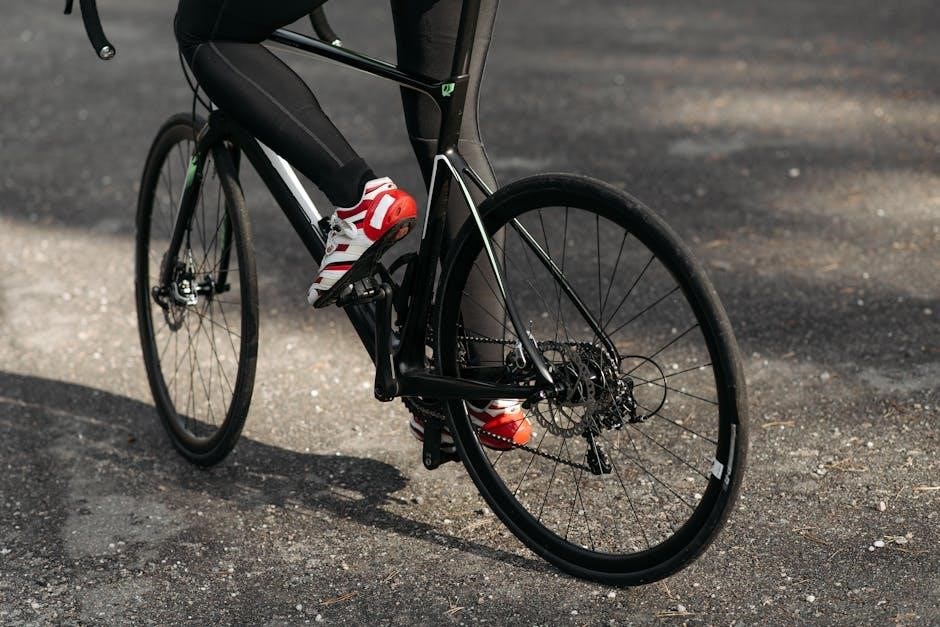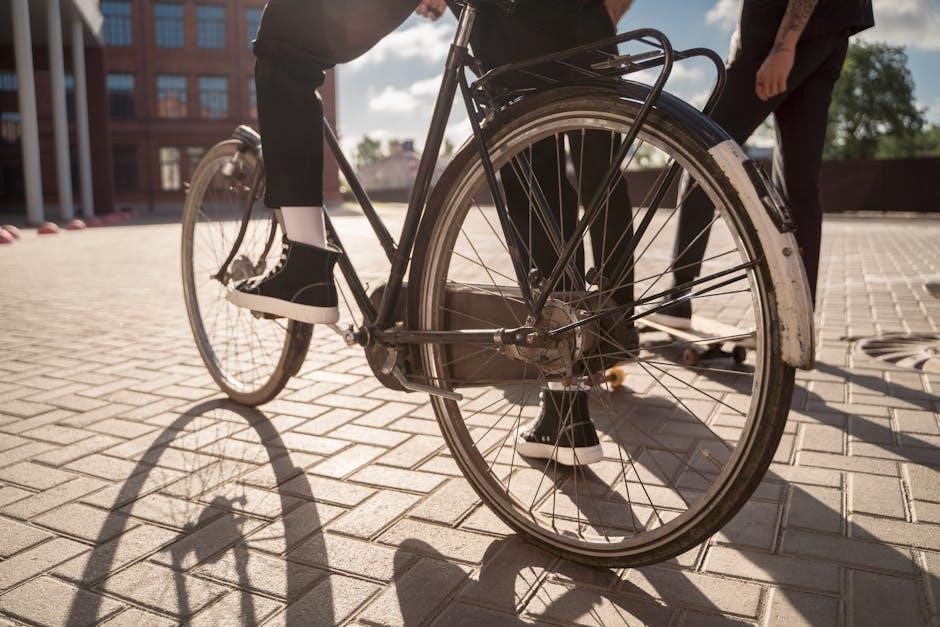
Welcome to our comprehensive guide on bike shoe sizing. Proper fit is crucial for performance, comfort, and safety. Cycling shoes differ from regular footwear, with sizing varying by brand and type. Understanding how to choose the right size ensures optimal pedaling efficiency and prevents discomfort. This guide will help you navigate size charts, conversion tips, and fitting advice to find your perfect pair.
Why Proper Fit Matters in Cycling Shoes
A proper fit in cycling shoes is essential for comfort, performance, and efficiency. Cycling shoes are designed to be snug, providing support and stability during pedaling. Ill-fitting shoes can lead to discomfort, blisters, or even pain, especially on long rides. A good fit ensures optimal power transfer, reduces foot fatigue, and enhances overall cycling performance. Poorly fitting shoes can also affect balance and control, making proper sizing a critical factor for both safety and enjoyment.
Understanding Bike Shoe Sizing
Bike shoe sizing varies by brand and type, often using European or US standards. Differences from regular shoes and manufacturer-specific fits make proper sizing crucial for comfort and performance.
European vs. US Sizing: Key Differences
European sizing uses whole numbers, while US sizing includes half sizes. Cycling shoes often follow European standards, as the sport originated there. Euro sizes are typically smaller than US equivalents, requiring careful conversion. Some brands only offer men’s sizing, which can confuse buyers. Always refer to the manufacturer’s chart for accurate fit, as differences can vary by brand and model, ensuring the right size for comfort and performance.
Differences Between Cycling Shoe Sizing and Regular Shoe Sizing
Cycling shoes tend to run smaller than regular shoes due to their snug, supportive design. They prioritize a tighter fit for efficiency and control, often requiring a half to full size smaller than everyday footwear. Width and shape also differ, with cycling shoes offering a more precise fit to prevent movement during pedaling. Always consult brand-specific charts, as sizing can vary significantly between manufacturers and models, ensuring optimal performance and comfort.

The Importance of a Snug Fit
A snug fit is essential for cycling shoes to ensure proper support, efficiency, and comfort. It prevents excessive movement, optimizing power transfer and reducing the risk of discomfort or injury.
How to Determine the Correct Tightness
To ensure the correct tightness, try cycling shoes in the evening, as feet tend to swell during the day. Wear your usual cycling socks for an accurate fit. The shoes should feel snug but not overly tight, with enough support to prevent excessive foot movement. Check that the width fits comfortably, avoiding pressure points. Aim for a slight gap between your toes and the shoe’s front for optimal comfort and performance.
Impact of Fit on Performance and Comfort
A well-fitting cycling shoe enhances performance by providing efficient power transfer and stability. Proper fit reduces foot fatigue and discomfort during long rides. Ill-fitting shoes can cause blisters, numbness, or pain, distracting from your cycling experience. A snug fit ensures optimal energy efficiency, while adequate support prevents foot movement that can lead to reduced control over the pedals. Comfort and performance are closely linked, making precise sizing essential for enjoyable and effective cycling.

Bike Shoe Size Charts and Conversion
Bike shoe sizing varies by brand and type, with charts offering precise conversions between US, EU, and UK sizes. Use manufacturer-specific guides for accuracy.
Shimano Cycling Shoe Size Chart
Shimano offers detailed size charts for men and women, ensuring a perfect fit. Their charts convert EU, US, and UK sizes, with measurements in centimeters. For example, a EU 36 corresponds to a US 4 and 22.5 cm heel-to-toe length. Shimano’s guide helps riders match their foot length to the ideal shoe size, optimizing comfort and performance during rides. Use their chart to find your accurate size and enjoy a snug, efficient fit.
Specialized Bike Shoe Size Conversion Chart
Specialized provides a clear conversion chart for cycling shoes, covering Euro, US, and UK sizes. For instance, a Euro size 35 equates to a US 3.5 and UK 2.5, with a 22.5 cm internal length. This chart helps riders accurately determine their size, ensuring a snug fit that enhances performance. Use Specialized’s guide to find your perfect size and enjoy a comfortable, efficient cycling experience tailored to your foot measurements.

How to Measure Your Feet for Cycling Shoes
Measure your feet using a ruler to find your internal shoe length. Ensure a 5-8mm gap between your longest toe and the shoe’s front for optimal fit.
Using Internal Shoe Length for Accurate Measurement
Internal shoe length is measured in millimeters, ensuring precise sizing. It refers to the distance from the heel to the toe box inside the shoe. For accuracy, measure your foot length and compare it to the manufacturer’s size chart. A recommended 5-8mm gap between your longest toe and the shoe’s front ensures a snug fit. This method helps avoid sizing errors and guarantees comfort during rides; Always refer to the brand’s specific chart for the best results.
Recommended Gap Between Toe and Shoe
A 5-8mm gap between your longest toe and the shoe’s front is ideal. This allows toes to wiggle slightly without pressure, preventing discomfort. Too little space can cause cramped toes, while excessive space may reduce control. This gap ensures a balance between fit and performance, enhancing comfort during long rides. Always consider this guideline when selecting your cycling shoes for optimal fit and functionality.
Comparing Bike Shoe Manufacturers
Each brand offers unique sizing and fit characteristics. Research individual manufacturer charts to ensure accuracy, as sizes can vary significantly across brands. Proper fit is crucial for performance.
Differences in Sizing Across Brands
Different brands often have varying sizing standards for cycling shoes. For instance, Shimano and Specialized may differ in their measurements, with some offering more room in the toe box while others provide a snugger fit. It’s essential to consult each brand’s specific size chart to ensure accuracy. Some brands may run larger or smaller than others, and personal foot shape can also influence the fit. Always check reviews or try shoes on if possible to avoid sizing mismatches.
Popular Brands and Their Fit Characteristics
Popular cycling shoe brands like Shimano, Specialized, and Giro each offer unique fit characteristics. Shimano shoes are known for their precise, snug fit, ideal for high-performance road cycling. Specialized shoes often feature a roomier toe box, catering to riders with wider feet. Giro emphasizes a balance between comfort and efficiency, offering both snug and relaxed fits depending on the model. Understanding these brand-specific traits helps cyclists choose shoes that align with their riding style and foot shape for optimal comfort and performance.

Cycling Shoe Fit for Different Types of Cycling
Different cycling disciplines require varying fits for optimal performance. Road cycling demands stiffness, while mountain biking needs traction, and triathlon shoes prioritize quick transitions. Proper fit enhances efficiency and comfort.
Road Cycling Shoes
Road cycling shoes prioritize stiffness and efficiency for optimal power transfer. They typically feature snug fits, with secure closures to prevent foot movement during intense efforts. Euro sizing is common, and sizes vary slightly across brands like Shimano or Specialized. Proper fit ensures comfort on long rides and prevents hotspots. Try shoes with cycling socks and check for a small toe gap. Road shoes often run smaller than casual footwear, so sizing down may be necessary for the best performance.
Mountain Bike Shoes
Mountain bike shoes are designed for durability and traction, often with recessed cleats for off-bike stability. They tend to have a roomier fit than road shoes, accommodating thicker socks and providing ankle protection. Sizing can vary by brand, with some using US sizing and others Euro. Ensure a snug but comfortable fit, allowing space for toes to move without pressure. Trying them on with hiking socks is recommended to ensure the right size for trail comfort.
Triathlon and Indoor Cycling Shoes
Triathlon and indoor cycling shoes prioritize quick transitions and comfort during high-intensity workouts. They often feature a snug, aerodynamic design with easy-to-use closures. Sizing tends to be similar to road shoes but may vary slightly between brands. A slightly roomier toe box can accommodate feet that swell during long rides. Ensure a secure fit that prevents hotspots, while allowing efficient power transfer for optimal performance in both indoor training and competitive triathlon events.
Women’s Cycling Shoe Sizing
Women’s cycling shoes are designed with narrower heel-to-foot ratios, catering to gender-specific foot shapes. Proper fit is essential for comfort and performance, avoiding overly tight or loose shoes.
Gender-Specific Design Differences
Women’s cycling shoes are tailored to accommodate narrower heel and ankle measurements compared to men’s shoes. They feature a more contoured fit, addressing the unique shape of women’s feet. These designs ensure better comfort and support, reducing discomfort during long rides. The smaller volume and precise fit help prevent slipping and hotspots, enhancing overall performance. Women-specific shoes are not just scaled-down versions of men’s shoes but are engineered to meet distinct anatomical needs.
Importance of Choosing Women’s Cycling Shoes
Selecting women’s cycling shoes ensures a better fit, comfort, and performance. They are designed to match female foot anatomy, providing optimal support and reducing discomfort. Proper fit prevents issues like numbness and hotspots, enhancing riding efficiency. Choosing women-specific shoes also improves power transfer and control, making every pedal stroke more effective. It’s essential to opt for shoes tailored to your needs rather than relying on smaller men’s sizes for the best cycling experience.
Trying Before Buying: In-Store Fittings
In-store fittings are crucial for ensuring the perfect fit. Try shoes with your cycling socks and walk around to assess comfort and support. This step guarantees satisfaction before purchase.
Why In-Store Fittings Are Crucial
In-store fittings ensure a precise fit, essential for performance and comfort. Cycling shoes vary in sizing and shape across brands, making in-person trials vital. Trying shoes on allows you to assess how they feel during movements, guaranteeing the right support and preventing issues like numbness or discomfort during rides. This step is especially important for first-time buyers unfamiliar with cycling shoe sizing differences.
What to Wear to a Fitting
When attending a bike shoe fitting, wear your regular cycling socks to ensure an accurate fit. Bring any orthotics or insoles you use to simulate real riding conditions. Avoid overly thick socks that might not reflect your usual cycling setup. Wearing tight or loose clothing won’t affect fitting, but focus on replicating your riding environment to get the best fit for optimal comfort and performance.

Winter Cycling Shoes: Special Considerations
Winter cycling shoes require extra space for thick socks to keep feet warm and dry. Ensure proper fit with insulation and waterproofing without compromising performance.
Accommodating Thicker Socks
Winter cycling shoes often need to accommodate thicker socks for warmth. When choosing a size, consider the extra space required to prevent tightness. A snug fit is essential, but overcrowding can lead to discomfort and reduced circulation. Opt for a slightly larger size than your regular fit to ensure there’s enough room for both your foot and the thicker socks without compromising performance or comfort during cold rides.
Winter-Specific Sizing Adjustments
Winter cycling requires specific sizing adjustments to ensure comfort and performance. Thicker socks mean cyclists may need a half to full size larger than their usual fit. Proper circulation and toe wiggle room are crucial to avoid numbness. Additionally, waterproof and insulated shoes often have a stiffer sole, which can affect fit. Always check the manufacturer’s winter-specific sizing guide to ensure the best fit for colder conditions and maintain optimal pedaling efficiency.
Common Mistakes to Avoid
Common mistakes include overlooking sizing differences between brands, not considering personal foot shape, and purchasing shoes too small or tight, which can hinder performance and comfort.
Overlooking Sizing Differences Between Brands
One major mistake cyclists make is assuming all brands follow the same sizing standards. European and US sizing systems differ, and even within these, brands like Shimano and Specialized may vary. For instance, a size 43 in Shimano might not fit the same as a size 43 in Specialized. Always refer to the specific brand’s size chart and consider trying shoes on before purchasing to ensure accuracy and comfort.
Not Considering Personal Foot Shape
Foot shape varies significantly among individuals, and ignoring this can lead to poor fit. Some may have wider feet or longer toes, requiring specific shoe widths or lengths. Many brands offer options for different foot shapes, but cyclists often overlook these details. Measure your feet accurately and consider both length and width when selecting cycling shoes to ensure proper fit and comfort.

Tips for the Perfect Fit
Ensure a snug fit for optimal performance and comfort. Use size charts, consider width, and try shoes with cycling socks. Proper fit enhances efficiency and reduces discomfort.
Using Shoe Size Finder Tools
Shoe size finder tools are invaluable for determining your ideal cycling shoe size. These tools often use your current shoe size to recommend the best fit. By matching internal shoe length in millimeters, they ensure accuracy. Many brands, like Shimano and Specialized, offer detailed charts. Use these tools to compare sizes and find your perfect match. Remember to try shoes with cycling socks for the best fit and double-check measurements for optimal comfort and performance.
Considering Width and Comfort
Width and comfort are essential for optimal cycling performance. Ensure your shoe isn’t overly tight, as this can restrict blood flow and cause discomfort. Regular and wide-fit options are available, catering to various foot shapes. Some brands offer a fit matrix, while others provide width-specific sizing. Try shoes with your usual cycling socks to assess comfort. A snug yet comfortable fit ensures better control and reduces fatigue during long rides, enhancing overall cycling efficiency and enjoyment.
Selecting the right bike shoe size is crucial for comfort and performance. Use size charts, consider width, and seek professional fittings to ensure a perfect fit.
Final Thoughts on Selecting the Right Size
Selecting the right cycling shoe size is vital for comfort and performance. Use brand-specific size charts, consider width, and visit a professional fitter. Remember, cycling shoes fit snugly, so downsize by half to a full size compared to regular shoes. Try them with your cycling socks and ensure a 5-8mm toe gap. Proper fit enhances efficiency, reduces discomfort, and improves your overall cycling experience.
Importance of Proper Fit for Enhanced Cycling Experience
A well-fitting cycling shoe enhances performance, comfort, and safety. Proper fit prevents hotspots, reduces fatigue, and improves power transfer. Snug yet comfortable shoes ensure efficient pedaling and better control. Ill-fitting shoes can lead to discomfort, reduced efficiency, and even injury. Prioritize a precise fit to maximize your cycling experience and enjoy a more enjoyable ride.
Leave a Reply
You must be logged in to post a comment.